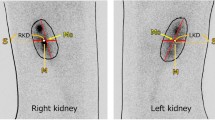Abstract
Gamma camera-based clearance techniques which use the renal uptake ratio (RUR) of the radiotracer are available to estimate the effective renal plasma flow (ERPF) and glomerular filtration rate. To evaluate the accuracy of these techniques, we measured RUR by an optimized procedure and compared it with standard ER-PF. Iodine-123 orthoiodohippurate (OIH) scintigraphy and simultaneouspara-aminohippurate clearance study for measuring standard ERPF were performed in three hospitals in 24 patients with normal or mildly impaired renal function. 1231-OIH was injected intravenously and 10-s consecutive imaging of the kidneys was started when the abdominal aorta was seen. The attenuation coefficient for 1231 was measured in each hospital using the same water-equivalent absorption materials and used for the attenuation correction. After subtracting background radioactivity, RURs were defined as the count ratios of fractional renal uptakes based on the integral from 1 to 2, 2 to 3, 1.5 to 2.5 and 1 to 3 min after the injection of 1231-OIH in relation to injected doses using the following three procedures in respect of attenuation correction: (1) RUR without attenuation correction, (2) RUR with fractional renal uptake corrected by the measured attenuation coefficient, (3) RUR with the total injected dose corrected by the absorption material. To decide upon the appropriate correction method and time interval, RURs were compared with standard ERPF. Among the three correction methods, procedure 2 showed the highest correlation between RUR and standard ERPF, but the correlation coefficient was low (r=0.75). No significant difference was observed among the RURs of each time interval. Individual kidney function measured from early renal uptake may be inaccurate even when appropriate correction is made for attenuation, background activity or time lag between injection and data acquisition. Gamma camera-based measurement of renal function using123I-OIH is limited with regard to accuracy and reproducibility, though it is convenient and non-invasive.
Similar content being viewed by others
References
Fritjofsson A, Persson, JE, Soderholm B, Vikterlof KJ. Quantitative determination of kidney function using radiorenography.Scand J Urol Nephrol 1973; 7: 215–222.
Tubis M, Posnick E, Nordyke RA. Preparation and use of 1311 labeled sodium iodohippurate in kidney function tests.Proc Soc Exp Biol Med 1960; 103: 497–498.
Burbank MK, Tauxe WN, Maher FT, Hunt JC. Evaluation of radioiodinated hippuran for the estimation of renal plasma flow.Proc Staff Meet Mayo Clin 1961; 36: 372–386.
Schwartz FD, Madeloff MS. Simultaneous renal clearances of radiohippuran and PAH in man [abstract].Clin Res 1961; 9: 208
Blaufox MD, Merrill JP. Simplified hippuran clearance: measurement of renal function in man with simplified hippuran clearances.Nephron 1966; 3: 274–281.
Blaufox MD. Compartmental analysis of the radiorenogram and kinetics of 1311 hippuran. In: Blaufox MD, Ed. Progress of nuclear medicine, vol. 2. Evaluation of renal function and disease with radionuclides. Baltimore: University Park Press; 1972: 107–146.
Hayes M, Brosman S, Taplin GV Determination of differential renal function by sequential renal scintigraphy.J Urol 1974;111:556–559.
Schlegel JU, Hamway SA. Individual renal plasma flow determination in 2 minutes.J Urol 1976; 116: 282–285.
Tauxe WN, Dubovsky EV, Kidd T Jr, Diaz F, Smith LR. New formulas for the calculation of effective renal plasma flow.Eur J Nucl Med 1982; 7: 51–54.
Thakur ML, Chauser BM, Hudson RF. The preparation of iodine-123 labelled sodium ortho-iodohippurate and its clearance by the rat kidneys.Int J Appl Radiat Isot 1975; 26: 319–320.
Wellman FIN, Berke RA, Robbins PJ, Anger RT Jr. Dynamic quantitative renal imaging with 1231-hippuran - a possible salvation of the renogram [abstract].J Nucl Med 1971; 12: 405–406
Zielinski FW Holly FE, Robinson GD Jr, Bennett LR. Total and individual kidney function assessment with iodine-123 ortho-iodohippurate.Radiology 1977; 125: 753–759.
Stadalnik RC, Vogel JM; Jansholt AL, et al. Renal clearance and extraction parameters of ortho-iodohippurate (1-123) compared with OIH (1-131) and PAH.J Nucl Med 1980; 21: 168–170.
Smith HW, Finkelstein N, Aliminosa L, Crawford B, Graber M. The renal clearances of substituted hippuric acid derivatives and other aromatic acids in dog an man.J Clin Invest 1945;24:388–404.
Yonome I. A new flexible water-equivalent material.Nippon Acta Radiol 1976; 36: 143–147.
Ito T, Takeda K, Toyota S, et al. Estimation of glomerular filtration rate from fractional renal uptake of99m-Tc-DTPA.Jpn J Nucl Med 1984; 21: 1579–1586.
Chachati A, Meyers A, Godon JP, Rigo P. Rapid method for the measurement of differential renal function: validation.J Nucl Med 1987; 28: 829–836.
Gates GF. Glomerular filtration rate: estimation from fractional renal accumulation of Tc-99m DTPA (stannous).AJR 1982; 138:565–570.
Gruenewald SM, Collins LT, Fawdry RM. Kidney depth measurement and its influence on quantitation of function from gamma camera renography.Clin Nucl Med 1985; 10: 398–401.
Maneval DC, Magill HL, Cypess AM, Rodman JH. Measurement of skin-to-kidney distance in children: implications for quantitative renography.J Nucl Med 1990; 31: 287–291.
Taylor A, Lewis C, Giacometti A, Hall EC, Barefield KP. Improved formulas for the estimation of renal depth in adults.J Nucl Med 1993; 34: 1766–1769.
Ito K, Tsukamoto E, Kakizaki H, Nonomura K, Furudate M. Comparative study of renal scintigraphy with99Tcm-mercapto-acetyltriglycine and123I-orthoiodohippurates.Nucl Med Commun 1993; 14: 644–652.
Dubovsky EV Russell CD. Quantitation of renal function with glomerular and tubular agents.Semin Nucl Med 1982; 4: 308–329.
Arroyo AJ. Effective renal plasma flow determination using technetium-99m-MAG3: comparison of two camera techniques with the Tauxe method.J Nucl Med Technol 1993; 21: 162–166.
Taylor A Jr, Corrigan PL, Galt J, et al. Measuring technetium99m-MAG3 clearance with an improved camera-based method.J Nucl Med 1995; 36: 1689–1695.
Flanigan WJ. Renal clearance measurements in man. In: Sunderman FW, Sunderman EW Jr, eds. Laboratory diagnosis of kidney diseases. St. Louis: Warren H. Green; 1970: 86–92.
Bubeck B, Brandau W Weber E, Kalble T, Palekh N, Georgi P. Pharmacokinetics of technetium-99m-MAG3 in humans.J Nucl Med 1990; 31: 1285–1293.
Author information
Authors and Affiliations
Rights and permissions
About this article
Cite this article
Oriuchi, N., Inoue, T., Hyashi, I. et al. Evaluation of gamma camera-based measurement of individual kidney function using iodine-123 orthoiodohippurate. Eur J Nucl Med 23, 371–375 (1996). https://doi.org/10.1007/BF01247363
Revised:
Issue Date:
DOI: https://doi.org/10.1007/BF01247363




